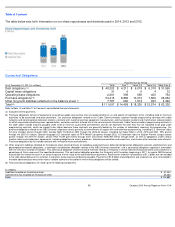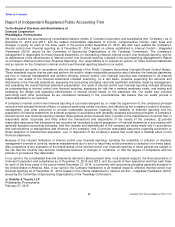Comcast 2014 Annual Report Download - page 82
Download and view the complete annual report
Please find page 82 of the 2014 Comcast annual report below. You can navigate through the pages in the report by either clicking on the pages listed below, or by using the keyword search tool below to find specific information within the annual report.-
 1
1 -
 2
2 -
 3
3 -
 4
4 -
 5
5 -
 6
6 -
 7
7 -
 8
8 -
 9
9 -
 10
10 -
 11
11 -
 12
12 -
 13
13 -
 14
14 -
 15
15 -
 16
16 -
 17
17 -
 18
18 -
 19
19 -
 20
20 -
 21
21 -
 22
22 -
 23
23 -
 24
24 -
 25
25 -
 26
26 -
 27
27 -
 28
28 -
 29
29 -
 30
30 -
 31
31 -
 32
32 -
 33
33 -
 34
34 -
 35
35 -
 36
36 -
 37
37 -
 38
38 -
 39
39 -
 40
40 -
 41
41 -
 42
42 -
 43
43 -
 44
44 -
 45
45 -
 46
46 -
 47
47 -
 48
48 -
 49
49 -
 50
50 -
 51
51 -
 52
52 -
 53
53 -
 54
54 -
 55
55 -
 56
56 -
 57
57 -
 58
58 -
 59
59 -
 60
60 -
 61
61 -
 62
62 -
 63
63 -
 64
64 -
 65
65 -
 66
66 -
 67
67 -
 68
68 -
 69
69 -
 70
70 -
 71
71 -
 72
72 -
 73
73 -
 74
74 -
 75
75 -
 76
76 -
 77
77 -
 78
78 -
 79
79 -
 80
80 -
 81
81 -
 82
82 -
 83
83 -
 84
84 -
 85
85 -
 86
86 -
 87
87 -
 88
88 -
 89
89 -
 90
90 -
 91
91 -
 92
92 -
 93
93 -
 94
94 -
 95
95 -
 96
96 -
 97
97 -
 98
98 -
 99
99 -
 100
100 -
 101
101 -
 102
102 -
 103
103 -
 104
104 -
 105
105 -
 106
106 -
 107
107 -
 108
108 -
 109
109 -
 110
110 -
 111
111 -
 112
112 -
 113
113 -
 114
114 -
 115
115 -
 116
116 -
 117
117 -
 118
118 -
 119
119 -
 120
120 -
 121
121 -
 122
122 -
 123
123 -
 124
124 -
 125
125 -
 126
126 -
 127
127 -
 128
128 -
 129
129 -
 130
130 -
 131
131 -
 132
132 -
 133
133 -
 134
134 -
 135
135 -
 136
136 -
 137
137 -
 138
138 -
 139
139 -
 140
140 -
 141
141 -
 142
142 -
 143
143 -
 144
144 -
 145
145 -
 146
146 -
 147
147 -
 148
148 -
 149
149 -
 150
150 -
 151
151 -
 152
152 -
 153
153 -
 154
154 -
 155
155 -
 156
156 -
 157
157 -
 158
158 -
 159
159 -
 160
160 -
 161
161 -
 162
162 -
 163
163 -
 164
164 -
 165
165 -
 166
166 -
 167
167 -
 168
168 -
 169
169 -
 170
170 -
 171
171 -
 172
172 -
 173
173 -
 174
174 -
 175
175 -
 176
176 -
 177
177 -
 178
178 -
 179
179 -
 180
180 -
 181
181 -
 182
182 -
 183
183 -
 184
184 -
 185
185 -
 186
186 -
 187
187 -
 188
188 -
 189
189 -
 190
190 -
 191
191 -
 192
192 -
 193
193 -
 194
194 -
 195
195 -
 196
196 -
 197
197 -
 198
198 -
 199
199 -
 200
200 -
 201
201 -
 202
202 -
 203
203 -
 204
204 -
 205
205 -
 206
206 -
 207
207 -
 208
208 -
 209
209 -
 210
210 -
 211
211 -
 212
212 -
 213
213 -
 214
214 -
 215
215 -
 216
216 -
 217
217 -
 218
218 -
 219
219 -
 220
220 -
 221
221 -
 222
222 -
 223
223 -
 224
224 -
 225
225 -
 226
226 -
 227
227 -
 228
228 -
 229
229 -
 230
230 -
 231
231 -
 232
232 -
 233
233 -
 234
234 -
 235
235 -
 236
236 -
 237
237 -
 238
238 -
 239
239 -
 240
240 -
 241
241 -
 242
242 -
 243
243 -
 244
244 -
 245
245 -
 246
246 -
 247
247 -
 248
248 -
 249
249 -
 250
250 -
 251
251 -
 252
252 -
 253
253 -
 254
254 -
 255
255 -
 256
256 -
 257
257 -
 258
258 -
 259
259 -
 260
260 -
 261
261 -
 262
262 -
 263
263 -
 264
264 -
 265
265 -
 266
266 -
 267
267 -
 268
268 -
 269
269 -
 270
270 -
 271
271 -
 272
272 -
 273
273 -
 274
274 -
 275
275 -
 276
276 -
 277
277 -
 278
278 -
 279
279 -
 280
280 -
 281
281 -
 282
282 -
 283
283 -
 284
284 -
 285
285 -
 286
286 -
 287
287 -
 288
288 -
 289
289 -
 290
290 -
 291
291 -
 292
292 -
 293
293 -
 294
294 -
 295
295 -
 296
296 -
 297
297 -
 298
298 -
 299
299 -
 300
300 -
 301
301 -
 302
302 -
 303
303 -
 304
304 -
 305
305 -
 306
306 -
 307
307 -
 308
308 -
 309
309 -
 310
310 -
 311
311 -
 312
312 -
 313
313 -
 314
314 -
 315
315 -
 316
316 -
 317
317 -
 318
318 -
 319
319 -
 320
320 -
 321
321 -
 322
322 -
 323
323 -
 324
324 -
 325
325 -
 326
326 -
 327
327 -
 328
328 -
 329
329 -
 330
330 -
 331
331 -
 332
332 -
 333
333 -
 334
334 -
 335
335 -
 336
336 -
 337
337 -
 338
338 -
 339
339 -
 340
340 -
 341
341 -
 342
342 -
 343
343 -
 344
344 -
 345
345 -
 346
346 -
 347
347 -
 348
348 -
 349
349 -
 350
350 -
 351
351 -
 352
352 -
 353
353 -
 354
354 -
 355
355 -
 356
356 -
 357
357 -
 358
358 -
 359
359 -
 360
360 -
 361
361 -
 362
362 -
 363
363 -
 364
364 -
 365
365 -
 366
366 -
 367
367 -
 368
368 -
 369
369 -
 370
370 -
 371
371 -
 372
372 -
 373
373 -
 374
374 -
 375
375 -
 376
376 -
 377
377 -
 378
378 -
 379
379 -
 380
380 -
 381
381 -
 382
382 -
 383
383 -
 384
384 -
 385
385 -
 386
386
 |
 |

Table of Contents
bypass the qualitative assessment and proceed directly to the quantitative impairment test. If it is determined, on the basis of
qualitative factors, that the fair value of the indefinite-
lived intangible is, more likely than not, less than its carrying value, the
quantitative impairment test is required. When performing a quantitative assessment, we estimate the fair value of our cable
franchise rights primarily based on a discounted cash flow analysis that involves significant judgment. When analyzing the fair
values indicated under the discounted cash flow models, we also consider multiples of operating income before depreciation and
amortization generated by the underlying assets, current market transactions and profitability information.
In 2014, we performed a quantitative assessment of our cable franchise rights. Based on our quantitative analysis, the estimated
fair values of our franchise rights exceeded the carrying value of the Northeast, Central and West divisions by 26%, 50% and 42%,
respectively.
Since the adoption of the accounting guidance related to goodwill and intangible assets in 2002, we have not recorded any
significant impairment charges to cable franchise rights as a result of our impairment testing. A future change in the unit of account
could result in the recognition of an impairment charge.
We could also record impairment charges in the future if there are changes in long-
term market conditions, in expected future
operating results, or in federal or state regulations that prevent us from recovering the carrying value of these cable franchise rights.
Assumptions made about increased competition and economic conditions could also impact the results of any qualitative
assessment and the valuations used in future annual quantitative impairment testing and result in a reduction in the fair values of
our cable franchise rights.
Film and Television Costs
We capitalize film and television production costs, including direct costs, production overhead, print costs, development costs and
interest. We amortize capitalized film and television production costs, including acquired libraries, and accrue costs associated with
participation and residual payments to programming and production expense. We generally record the amortization and the
accrued costs using the individual film forecast computation method, which amortizes such costs using the ratio of the current
period’s revenue to estimated total remaining gross revenue from all sources (“ultimate revenue”).
Estimates of ultimate revenue
have a significant impact on how quickly capitalized costs are amortized and, therefore, are updated regularly.
Our estimates of ultimate revenue for films generally include revenue from all sources that are expected to be earned within 10
years from the date of a film’
s initial release. These estimates are based on the historical performance of similar content, as well as
factors unique to the content itself. The most sensitive factor affecting our estimate of ultimate revenue for a film intended for
theatrical release is the film’
s theatrical performance, as subsequent revenue from the licensing and sale of a film has historically
exhibited a high correlation to its theatrical performance. Upon a film’
s release, our estimates of revenue from succeeding markets,
including home entertainment and other distribution platforms, are revised based on historical relationships and an analysis of
current market trends.
With respect to television series or other owned television programming, the most sensitive factor affecting our estimate of ultimate
revenue is whether the series can be successfully licensed beyond its initial license. Initial estimates of ultimate revenue are limited
to the amount of revenue contracted for each episode under the initial license. Once it is determined that a television series or other
owned television programming can be licensed for subsequent platforms, revenue estimates for these platforms, such as U.S. and
international syndication, home entertainment, and other distribution platforms, are included in ultimate revenue. Revenue
estimates for produced episodes include revenue expected to be earned within 10 years of delivery of the initial episode or, if still in
production, 5 years from the delivery of the most recent episode, if later.
77
Comcast 2014 Annual Report on Form 10
-
K
